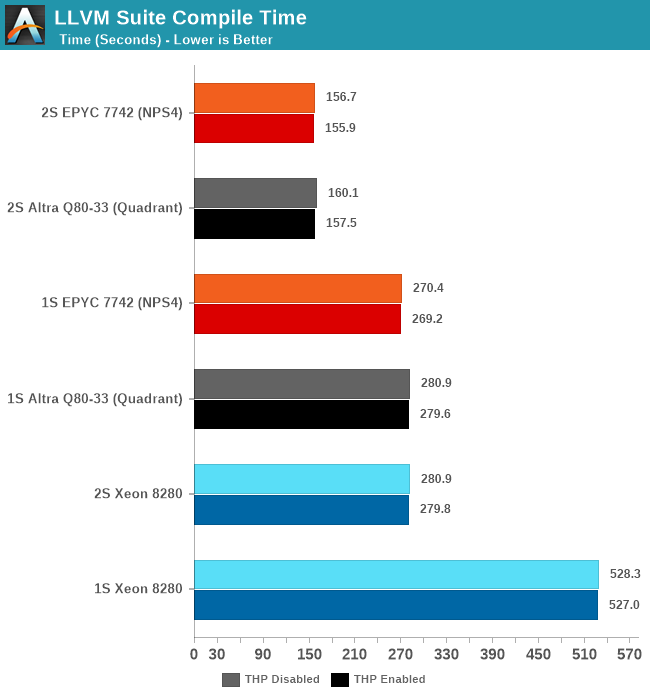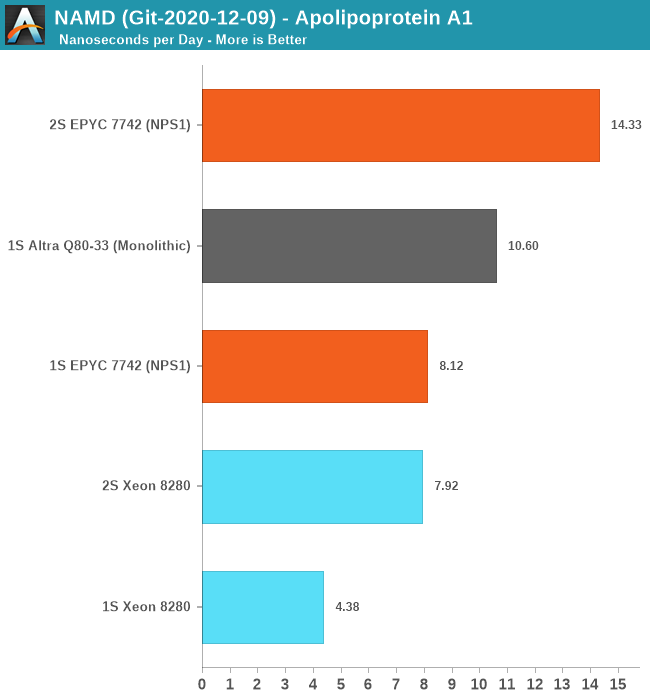The Ampere Altra Review: 2x 80 Cores Arm Server Performance Monster
by Andrei Frumusanu on December 18, 2020 6:00 AM EST- Posted in
- Servers
- Neoverse N1
- Ampere
- Altra
Compiling LLVM, NAMD Performance
As we’re trying to rebuild our server test suite piece by piece – and there’s still a lot of work go ahead to get a good representative “real world” set of workloads, one more highly desired benchmark amongst readers was a more realistic compilation suite. Chrome and LLVM codebases being the most requested, I landed on LLVM as it’s fairly easy to set up and straightforward.
git clone https://github.com/llvm/llvm-project.gitcd llvm-projectgit checkout release/11.xmkdir ./buildcd ..mkdir llvm-project-tmpfssudo mount -t tmpfs -o size=10G,mode=1777 tmpfs ./llvm-project-tmpfscp -r llvm-project/* llvm-project-tmpfscd ./llvm-project-tmpfs/buildcmake -G Ninja \ -DLLVM_ENABLE_PROJECTS="clang;libcxx;libcxxabi;lldb;compiler-rt;lld" \ -DCMAKE_BUILD_TYPE=Release ../llvmtime cmake --build .We’re using the LLVM 11.0.0 release as the build target version, and we’re compiling Clang, libc++abi, LLDB, Compiler-RT and LLD using GCC 10.2 (self-compiled). To avoid any concerns about I/O we’re building things on a ramdisk – on a 4KB page system 5GB should be sufficient but on the Altra’s 64KB system it used up to 9.5GB, including the source directory. We’re measuring the actual build time and don’t include the configuration phase as usually in the real world that doesn’t happen repeatedly.

The Altra Q80-33 here performs admirably and pretty much matches the AMD EPYC 7742 both in 1S and 2S configurations. There isn’t exact perfect scaling between sockets because this being a actual build process, it also includes linking phases which are mostly single-threaded performance bound.
Generally, it’s interesting to see that the Altra here fares better than in the SPEC 502.gcc_r MT test – pointing out that real codebases might not be quite as demanding as the 502 reference source files, including a more diverse number of smaller files and objects that are being compiled concurrently.
NAMD
Another rather popular benchmark tool that we’ve actually seen being used by vendors such as AMD in their marketing materials when showcasing HPC performance for their server chips is NAMD. This actually quite an interesting adventure in terms of compiling the tool for AArch64 as essentially there little to no proper support for it. I’ve used the latest source drop, essentially the 2.15alpha / 3.0alpha tree, and compiled it from scratch on GCC 10.2 using the platform’s respective -march and -mtune targets.
For the Xeon 8280 – I did not use the AVX512 back-end for practical reasons: The code which introduces an AVX512 algorithm and was contributed by Intel engineers to NAMD has no portability to compilers other than ICC. Beyond this being a code-path that has no relation with the “normal” CPU algorithm – the reliance on ICC is something that definitely made me raise my eyebrows. It’s a whole other discussion topic on having a benchmark with real-world performance and the balance of having an actual fair and balanced apple to apples comparison. It’s something to revisit in the future as I invest more time into looking the code and see if I can port it to GCC or LLVM.

For the single-socket numbers – we’re using the multicore variant of the tool which has predictable scaling across a single NUMA node. Here, the Ampere Altra Q80-33 performed amazingly well and managed to outperform the AMD EPYC 7742 by 30% - signifying this is mostly a compute-bound workload that scales well with actual cores.
For the 2S figures, using the multicore binaries results in undeterministic performance – the Altra here regressed to 2ns/day and the EPYC system also crashed down to 4ns/day – oddly enough the Xeon system had absolutely no issue in running this properly as it had excellent performance scaling and actually outperforms the MPI version. The 2S EPYC scales well with the MPI version of the benchmark, as expected.
Unfortunately, I wasn’t able to compile an MPI version of NAMD for AArch64 as the codebase kept running into issues and it had no properly maintained build target for this. In general, I felt like I was amongst the first people to ever attempt this, even though there are some resources to attempt to help out on this.
I also tried running Blender on the Altra system but that ended up with so many headaches I had to abandon the idea – on CentOS there were only some really old build packages available in the repository. Building Blender from source on AArch64 with all of its dependencies ends up in a plethora of software packages which simply assume you’re running on x86 and rely on basic SSE intrinsics – easy enough to fix that in the makefiles, but then I hit some other compilation errors after which I lost my patience. Fedora Linux seemed to be the only distribution offering an up-to-date build package for Blender – but I stopped short of reinstalling the OS just to benchmark Blender.
So, while AArch64 has made great strides in the past few years – and the software situation might be quite good for server workloads, it’s not all rosy and we’re still have ways to go before it can be considered a first-class citizen in the software ecosystem. Hopefully Apple’s introduction of Apple Silicon Macs will accelerate the Arm software ecosystem.










148 Comments
View All Comments
Wilco1 - Monday, December 21, 2020 - link
Using Zen 2 is not correct since it uses much larger transistors. Using Kirin 990 5G density gives an estimate of 330mm^2 for Graviton 2. The size of N1 cores has been published for 7nm, so we know it is 1.4mm^2. You're right that PCIe lanes would add to it as well - assuming the PHYs have the same size as DDR PHYs at the same speed, 64 lanes would be about 12-15mm^2. That would increase it to about 365mm^2.milli - Monday, December 21, 2020 - link
Kirin 990 5G uses N7+. Altra uses N7.Not only is the process different but they're also totally different categories of products concerning transistor density. A mobile SOC can be very dense. It barely has any IO (which is not transistor dense). Also GPU, DPU, IMG, ... all are extremely dense.
Kirin 990 5G is 90MTr/mm^2.
No way a server class SOC is going to be more than 60MTr/mm2.
Renoir = 62, Navi 21 = 52, Zen2 = 54, Vega 20 = 40, Navi 10 = 41.
Ampere isn't going to magically break 60.
"The size of N1 cores has been published for 7nm, so we know it is 1.4mm^2"
Those are ARM numbers and that is only if you use high density libraries.
Wilco1 - Monday, December 21, 2020 - link
Arm servers don't need high performance libraries - even mobile phones clock over 3 GHz using high density libraries. See https://images.anandtech.com/doci/13959/03_Infra%2... (note 3.1GHz and 1.4mm^2 with 1MB L2 on 7nm is ~100MT/mm^2)Using ~90MT/mm^2 for 7nm is reasonable since that is the reported density of recent 7nm chips (Kirin 990 5G is 91, 4G is 88 - the older 980 gets 93). Mobile SoCs already have a large amount of IO and analog logic and we are multiplying that amount by 3x.
This shows how stupid it is to use high performance libraries in server chips - they don't need to run at 5GHz!
milli - Monday, December 21, 2020 - link
We have different opinions but there's only one true fact: the die size is not disclosed. So anything anyone says is just a pure guess. You can't throw it around as fact.milli - Monday, December 21, 2020 - link
Navi 10/20 chips run at < 2Ghz and are 40MTr/mm. Just because Altra runs at 3.3Ghz, doesn't mean that it doesn't use HPL.Josh128 - Friday, December 18, 2020 - link
Exactly-- no way in hell this thing is just 350mm^2. The package is huge. Why would a 350mm^2 die need such a giant package?Wilco1 - Friday, December 18, 2020 - link
The package is only 16% larger than EPYC. Do you see any opportunity to reduce the huge number of pins? There are 8 memory channels plus full 128 PCIe lanes.mode_13h - Sunday, December 20, 2020 - link
Yes, the problem Altra Max will likely face is more memory bottlenecks. Also, I wonder if they'll have to dial clocks down, a little, to keep the power-efficiency numbers attractive.Wilco1 - Monday, December 21, 2020 - link
Altra Max drops max frequency to 3GHz, but it's not clear whether the TDP stays the same.Gondalf - Friday, December 18, 2020 - link
Are you sure :). Come on